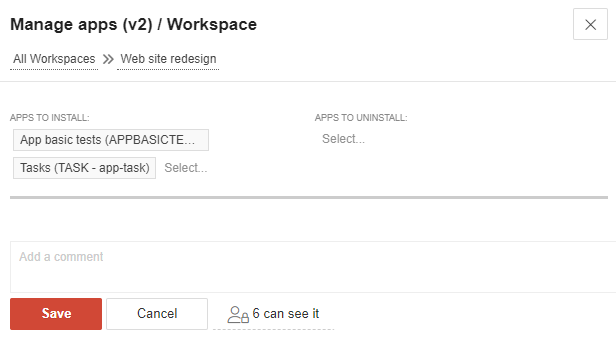Install and manage apps
Install and configure applications to meet your workspace needs, ensuring appropriate access control and functionality for your team.
Default app installation
Pre-installed applications
Upon workspace creation, several default apps are automatically installed:
- Core apps - typically include "Tasks", "Tags", and other essential applications
- System configuration - default apps depend on your system configuration
- Foundation setup - provides basic functionality to get started immediately
Initial configuration
- Ready to use - default apps are configured for immediate use
- Customizable - modify default settings to match your specific requirements
- Expandable - add additional apps as your needs grow
App installation process
Workspace admin responsibilities
Workspace administrators are responsible for app selection and access control:
- Strategic selection - choose apps that support your team's workflow and objectives
- Access management - grant appropriate permissions to workspace participants
- Configuration oversight - ensure apps are properly configured for your use case
Installation examples
- Universal access - install "Bugs" app accessible to all workspace participants
- Restricted access - install "Invoices" app accessible only to users in the "Accounting" group
- Role-based deployment - align app access with organizational roles and responsibilities
Installation interface
Accessing app management
Perform app installation from the workspace overview page:
- Manage apps (v2) - use this menu item to access the app management interface
- Centralized control - manage all workspace apps from a single location
- Visual interface - intuitive interface for app selection and configuration
App selection process
The workspace admin should select which apps to install:

App management strategy
Selection criteria
Consider these factors when choosing apps for your workspace:
- Team needs - identify what functionality your team requires
- Workflow alignment - ensure apps support your existing processes
- User capabilities - consider the technical skills of your team members
- Integration requirements - evaluate how apps work together
Access planning
Plan app access based on your organizational structure:
- Role-based access - align app permissions with job functions
- Security requirements - restrict sensitive apps to appropriate users
- Collaboration needs - ensure teams can access tools they need to work together
Implementation approach
- Phased rollout - install apps incrementally to avoid overwhelming users
- User training - provide training and support for new applications
- Feedback collection - gather user input on app effectiveness and usability
Best practices
App governance
- Documentation - maintain records of app purposes and configurations
- Regular review - periodically assess app usage and effectiveness
- Cleanup - remove unused apps to reduce complexity and maintenance overhead
User experience
- Consistent interface - maintain consistent app configurations across workspaces
- Clear permissions - ensure users understand what they can access
- Support resources - provide help and documentation for app usage
Performance considerations
- Resource monitoring - track system resources used by installed apps
- Optimization - configure apps for optimal performance
- Scalability - plan for future growth and additional app requirements
Effective app management ensures your workspace has the right tools for your team's success while maintaining security and performance standards.